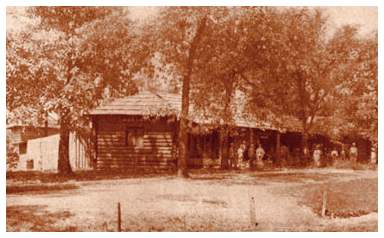Oregon's entry was a reproduction of the buildings and stockade used by Lewis and Clark in the winter of 1805-06, known in history as Fort Clatsop. This fort was built by the explorers' party at the mouth of the Columbia river on the territory of the Clatsop Indians. It was the first building constructed in the Oregon country on the Pacific coast by European Americans.
The state building was a fort in a primitive style of architecture, one story high and irregular in form. It measured 60 by 90 feet, and cost 5,000 dollars.
The building included a 600-seat restaurant.
In the Horticultural Building about 50 exhibitors displayed specimens of
the fruits of Oregon. Apples, pears, and prunes were shown in interesting variety and unexcelled quality.
In the Mines and Metallurgy Palace, there was a very unique and interesting display of mineral specimens, many of which were loaned to the State of Oregon for use at the exposition. Among the specimens there were collections of gold quartz and nuggets from the various gold mines of the State. Besides the gold, there were shown collections of polished pebble, copper ores, native silver, including cobalt and antimony ores, crystals, opals, marble, jasper, asbestos, limestone, kaolin, asphaltum, and tellurium ores.
There were also displayed Indian curios.
Oregon's display at the Palaces of Agriculture, and Forestry, Fish and Game were also noteworthy.
At one end of Oregon's display at the Palace of Forestry, Fish, and Game was a fine exhibit of game birds such as ducks and pheasants, as well as fish.




